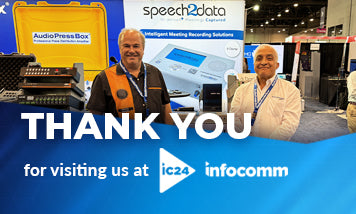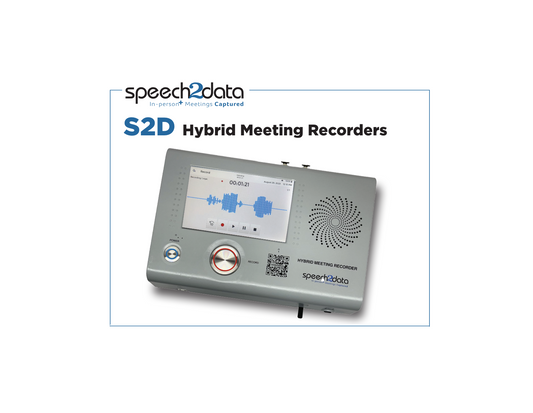Selecting the Best Speech-to-Data Applications
Share
Technology has made our personal and professional lives far easier to manage over the past 25 years, gradual to exponential improvements that used to take years and now only in a matter of months or weeks. It is seemingly uncomplicated with mostly user-friendly interfaces that require only a few keystrokes or taps on a screen to get the results you want.
Yet, technology is still very complex and multi-tiered, with a myriad of competitive platforms from which to choose to achieve the ideal outcomes. This is when it becomes confusing and sometimes daunting to make the right decision(s) for your particular needs. For some, even when deciding between an iPhone or Android is not easy because there are many similarities yet quite a few differences.
In the speech-to-data or text space, to determine the best application choice to use with your particular hardware setup is dependent on many business factors. Aside from just transcription for meetings, what could be other purposes for this application? How many speakers will need to be recorded in a meeting? Will there be speakers who must speak in different languages? What is the environment – conference room, courthouse, large event space, etc., - at this meeting? Will there be occasions where only dictation is needed? What hardware will be used and will Internet access be required or not? These are just some of the requirements that you need to compare the features for the top applications for transcriptions and translations, then from there make the final selection.
Important Speech-to-Data App features
To make it easier for those of us who are confronted with multiple excellent choices, we’ve summarized a comprehensive list of important features to help, that are available in the best-in-class speech-to-data or text transcription and translation applications. Some features you might not require, which help you opt for another application with more basic features. Remember that even if you’ve chosen a speech-to-data application and discovered it is lacking in features that you do need, it is never too late to make the switch.
- Accuracy and Reliability: High transcription accuracy is crucial. Some apps can reach up to 98.86% accuracy for real-time transcriptions – so don’t expect 100%. Also look for the ability to recognize various accents and dialects with real-time error correction and adaptive learning capabilities to improve accuracy over time. High accuracy rates are achieved through advanced algorithms and extensive training data.
- Language Support: Broad language support enhances usability across different regions and for regions where multiple languages are spoken. Some apps have transcription for up to 58 languages.
- Real-Time Transcription: Real-time transcription capabilities are vital for meetings and live. Automatic insertion of punctuation and appropriate formatting helps produce readable and professional-looking transcripts.
- Editing and Collaboration: Features that allow for live editing and collaboration are important for team environments. If you need this feature, look for robust team collaboration tools, including the ability to edit, highlight, and add comments.
- Integration and Compatibility with Other Tools: Integration with other tools such as calendars, CRM, and note-taking apps is essential for workflow efficiency. Also compatibility with operating systems such as Windows, macOS, iOS, Android.
- Security and Privacy: Ensuring the security and privacy of transcribed data is critical. Include strong security measures to protect user data, including end-to-end encryption and clear privacy policies and options to manage data storage and sharing preferences.
- Export Options: Versatility in export formats (e.g., text, Word, PDF, SRT) and integration with platforms like Notion and Salesforce is a significant advantage.
- User-friendly Interface: Easy to navigate, with an intuitive and easy-to-use interface allows users to start transcribing quickly without a steep learning curve.
- AI Features: Advanced AI features, such as automatic summarization and action item generation, can greatly enhance productivity.
- Customization and User Control: Customizable dictionaries and the ability to add specific terminology relevant to the user’s industry or needs; user-friendly interfaces with easy access to settings and customization options.
- Offline Functionality: Ability to transcribe speech without an internet connection for better privacy and reliability in areas with poor connectivity.
- Support for Multiple Languages: Multilingual support is essential for global accessibility, allowing users to transcribe speech in various languages and dialects.
- Voice Commands: Support for voice commands can enhance productivity by allowing users to control the application hands-free.
- Additional Features: Speaker identification and separation for multi-speaker environments. Transcription editing tools, such as timestamp insertion and easy text correction.
Highly Rated Applications
Wondering where to start? Determine your needs based on the features outlined above, then compare these apps to see which is the best for your speech-to-data or text transcription, dictation and translation requirements. Listed below, in no preferential order, are the apps to consider and compare against each other:
- Otter:
- Advanced features for live editing and secure storage.
- Otter.ai is favored for its highly accurate real-time transcription, easy-to-use interface, and collaborative features, which allow users to share and edit transcripts in real-time.
- Integrates with various platforms, including Zoom and Microsoft Teams.
- Trint:
- Offers powerful team collaboration tools and high-quality transcription in multiple languages.
- Trint's custom vocabulary builder enhances accuracy, especially for industry-specific terms.
- Notta:
- Combines a wide range of features including real-time transcription, multiple language support, AI summarization, and extensive export options.
- It is well-regarded for its ease of use and integration capabilities.
- Google Speech-to-Text:
- Known for its high accuracy and extensive language support.
- Integrates well with other Google services and offers powerful machine learning capabilities.
- Google offers powerful APIs for integration. It also benefits from continuous improvements through Google's extensive AI research.
- Dragon NaturallySpeaking:
- Highly regarded for its accuracy and customization options.
- User-friendly interface and high accuracy, especially in specialized fields like medical and legal transcription.
- Offers industry-specific versions and powerful voice command capabilities.
- Microsoft Azure Speech to Text:
- Provides robust accuracy and integrates well with Microsoft's ecosystem.
- Offers customizable language models and supports a wide range of languages.
- IBM Watson Speech to Text:
- IBM Watson is recognized for its advanced AI capabilities, high accuracy, and extensive customization options.
- Includes custom vocabulary and language model adaptation.
At Speech2Data, we support small towns and communities in areas across the United States that are underserved for their access to federally funded services and critical information. While Speech2Data's hybrid meeting recorder is an ideal solution for these communities for use in their municipal and court settings, we strive to provide additional information that would assist in areas that include technology and beyond. In this article, we outline the use of speech-to-data applications that can be integrated with our innovative and easy-to-use Speech2Data hybrid meeting recorder.




